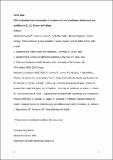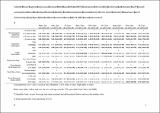Files in this item
Unhealthy food consumption in adolescence : role of sedentary behaviours and modifiers in 11-, 13- and 15-year-old Italians
Item metadata
| dc.contributor.author | Borraccino, Alberto | |
| dc.contributor.author | Lemma, Patrizia | |
| dc.contributor.author | Berchialla, Paola | |
| dc.contributor.author | Cappello, Nazario | |
| dc.contributor.author | Inchley, Joanna Catherine | |
| dc.contributor.author | Dalmasso, Paola | |
| dc.contributor.author | Charrier, Lorena | |
| dc.contributor.author | Cavallo, Franco | |
| dc.contributor.author | Italian HBSC 2010 Group | |
| dc.date.accessioned | 2017-04-17T04:38:16Z | |
| dc.date.available | 2017-04-17T04:38:16Z | |
| dc.date.issued | 2016-08-01 | |
| dc.identifier | 242058354 | |
| dc.identifier | b903fee7-5819-4f6f-a0b9-9a76c8e18cf8 | |
| dc.identifier | 84984697550 | |
| dc.identifier | 000383233800025 | |
| dc.identifier.citation | Borraccino , A , Lemma , P , Berchialla , P , Cappello , N , Inchley , J C , Dalmasso , P , Charrier , L , Cavallo , F & Italian HBSC 2010 Group 2016 , ' Unhealthy food consumption in adolescence : role of sedentary behaviours and modifiers in 11-, 13- and 15-year-old Italians ' , European Journal of Public Health , vol. 26 , no. 4 , pp. 650-656 . https://doi.org/10.1093/eurpub/ckw056 | en |
| dc.identifier.issn | 1101-1262 | |
| dc.identifier.other | ORCID: /0000-0001-8322-8817/work/65014252 | |
| dc.identifier.uri | https://hdl.handle.net/10023/10620 | |
| dc.description | This work is part of the Project ‘Sistema di indagini sui rischi comportamentali in eta` 6-17 anni’ promoted and financed by the Ministry of Health (cap. 4393/2005-CCM). | en |
| dc.description.abstract | Backgrounds and aim. Unhealthy eating behaviours increase with age and have been associated with adverse health consequences in adulthood. We examined the influence of screen-based sedentary behaviours (SBs) on unhealthy food consumption, such as energy-dense foods and sweetened drinks, among a representative sample of nearly 60 000 adolescents and assessed the role of possible modifiers. Methods. Data come from the Italian 2009–10 Health Behaviour in School-aged Children (HBSC) survey. Data on Eating patterns, SBs, physical activity, peers network, BMI and socio-economic status (SES) were collected following the HBSC study protocol. Hierarchical logistic regression models were used. Results. Unhealthy food consumption was significantly associated with a lower intake of fruit and vegetables and with the increase of SBs in both sexes and in all ages. The risk was interestingly higher in normal weight adolescents, in those with wider relationships with peers and in low SES children. Conclusions. This study adds evidence to support the importance of investing more resources in educational initiatives both to increase parents’ awareness to support adolescents on dietary choices and on time spent in screen-based behaviours, independently of their adiposity status; and to develop youth’s ability to access and appropriately use media and technologies. Policy makers should also increase their attention on introducing regulatory policies on television food advertising to which youth are exposed. | |
| dc.format.extent | 350167 | |
| dc.format.extent | 283754 | |
| dc.format.extent | 257387 | |
| dc.language.iso | eng | |
| dc.relation.ispartof | European Journal of Public Health | en |
| dc.subject | RA0421 Public health. Hygiene. Preventive Medicine | en |
| dc.subject | RJ101 Child Health. Child health services | en |
| dc.subject | NDAS | en |
| dc.subject | SDG 3 - Good Health and Well-being | en |
| dc.subject.lcc | RA0421 | en |
| dc.subject.lcc | RJ101 | en |
| dc.title | Unhealthy food consumption in adolescence : role of sedentary behaviours and modifiers in 11-, 13- and 15-year-old Italians | en |
| dc.type | Journal article | en |
| dc.contributor.institution | University of St Andrews. School of Medicine | en |
| dc.contributor.institution | University of St Andrews. Child and Adolescent Health Research Unit | en |
| dc.identifier.doi | 10.1093/eurpub/ckw056 | |
| dc.description.status | Peer reviewed | en |
| dc.date.embargoedUntil | 2017-04-16 |
This item appears in the following Collection(s)
Items in the St Andrews Research Repository are protected by copyright, with all rights reserved, unless otherwise indicated.



